High efficiency power supply for LED lighting applications
a technology of led lighting and power supply, which is applied in the direction of instruments, light sources, electrical equipment, etc., can solve the problems of less accurate control of current in the other led strand, waste of power and excess heat generated in the system, and wasting a significant amount of power, so as to achieve the highest efficiency operating point and accurate current regulation
- Summary
- Abstract
- Description
- Claims
- Application Information
AI Technical Summary
Benefits of technology
Problems solved by technology
Method used
Image
Examples
Embodiment Construction
[0021] The invention provides a power supply for efficiently driving plural LED strands in which multiple current regulators feed back control information to a single voltage regulator or converter, allowing the power supply to adjust the output voltage to the optimum setpoint for varying load conditions.
[0022] More particularly, the power supply provides directly regulated multiple load currents with an indirectly regulated single output voltage. Linear current regulators independently regulate the load currents, and the output voltage of the voltage regulator or converter is adjusted using feedback information from all current regulators. This allows very accurate current regulation under changing output voltage conditions, as well as the ability to switch between several operating conditions as different loads are energized or de-energized. Moreover, the voltage regulator or converter does not need a pre-determined output voltage setpoint and always seeks the lowest possible out...
PUM
 Login to View More
Login to View More Abstract
Description
Claims
Application Information
 Login to View More
Login to View More - R&D
- Intellectual Property
- Life Sciences
- Materials
- Tech Scout
- Unparalleled Data Quality
- Higher Quality Content
- 60% Fewer Hallucinations
Browse by: Latest US Patents, China's latest patents, Technical Efficacy Thesaurus, Application Domain, Technology Topic, Popular Technical Reports.
© 2025 PatSnap. All rights reserved.Legal|Privacy policy|Modern Slavery Act Transparency Statement|Sitemap|About US| Contact US: help@patsnap.com



